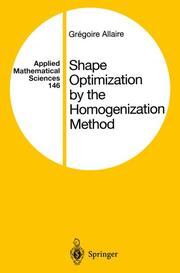-
Zusatztext
-
Inhaltsangabe1 Homogenization.- 1.1 Introduction to Periodic Homogenization.- 1.1.1 A Model Problem in Conductivity.- 1.1.2 Two-scale Asymptotic Expansions.- 1.1.3 Variational Characterizations and Estimates of the Effective Tensor.- 1.1.4 Generalization to the Elasticity System.- 1.2 Definition of H-convergence.- 1.2.1 Some Results on Weak Convergence.- 1.2.2 Problem Statement.- 1.2.3 The One-dimensional Case.- 1.2.4 Main Results.- 1.3 Proofs and Further Results.- 1.3.1 Tartar's Method.- 1.3.2 G-convergence.- 1.3.3 Homogenization of Eigenvalue Problems.- 1.3.4 A Justification of Periodic Homogenization.- 1.3.5 Homogenization of Laminated Structures.- 1.3.6 Corrector Results.- 1.4 Generalization to the Elasticity System.- 1.4.1 Problem Statement.- 1.4.2 H-convergence.- 1.4.3 Lamination Formulas.- 2 The Mathematical Modeling of Composite Materials.- 2.1 Homogenized Properties of Composite Materials.- 2.1.1 Modeling of Composite Materials.- 2.1.2 The G-closure Problem.- 2.2 Conductivity.- 2.2.1 Laminated Composites.- 2.2.2 Hashin-Shtrikman Bounds.- 2.2.3 G-closure of Two Isotropic Phases.- 2.3 Elasticity.- 2.3.1 Laminated Composites.- 2.3.2 Hashin-Shtrikman Energy Bounds.- 2.3.3 Toward G-closure.- 2.3.4 An Explicit Optimal Bound for Shape Optimization.- 3 Optimal Design in Conductivity.- 3.1 Setting of Optimal Shape Design.- 3.1.1 Definition of a Model Problem.- 3.1.2 A first Mathematical Analysis.- 3.1.3 Multiple State Equations.- 3.1.4 Shape Optimization as a Degeneracy Limit.- 3.1.5 Counterexample to the Existence of Optimal Designs.- 3.2 Relaxation by the Homogenization Method.- 3.2.1 Existence of Generalized Designs.- 3.2.2 Optimality Conditions.- 3.2.3 Multiple State Equations.- 3.2.4 Gradient of the Objective Function.- 3.2.5 Self-adjoint Problems.- 3.2.6 Counterexample to the Uniqueness of.- Optimal Designs.- 4 Optimal Design in Elasticity.- 4.1 Two-phase Optimal Design.- 4.1.1 The Original Problem.- 4.1.2 Counterexample to the Existence of Optimal Designs.- 4.1.3 Relaxed Formulation of the Problem.- 4.1.4 Compliance Optimization.- 4.1.5 Counterexample to the Uniqueness of Optimal Designs.- 4.1.6 Eigenfrequency Optimization.- 4.2 Shape Optimization.- 4.2.1 Compliance Shape Optimization.- 4.2.2 The Relaxation Process.- 4.2.3 Link with the Michell Truss Theory.- 5 Numerical Algorithms.- 5.1 Algorithms for Optimal Design in Conductivity.- 5.1.1 Optimality Criteria Method.- 5.1.2 Gradient Method.- 5.1.3 A Convergence Proof.- 5.1.4 Numerical Examples.- 5.2 Algorithms for Structural Optimization.- 5.2.1 Compliance Optimization.- 5.2.2 Numerical Examples.- 5.2.3 Technical Algorithmic Issues.- 5.2.4 Penalization of Intermediate Densities.- 5.2.5 Quasiconvexification versus Convexification.- 5.2.6 Multiple Loads Optimization.- 5.2.7 Eigenfrequency Optimization.- 5.2.8 Partial Relaxation.
-
Detailansicht
Shape Optimization by the Homogenization Method
Applied Mathematical Sciences 146
ISBN/EAN: 9781441929426
Umbreit-Nr.: 959292
Sprache:
Englisch
Umfang: xvi, 458 S.
Format in cm:
Einband:
kartoniertes Buch
Erschienen am 03.12.2010
Auflage: 1/2002


